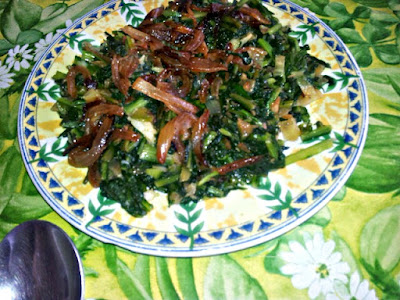Guest Post by Food Technologist Francine Francis  |
| Chicory Leaves |
Chicory (Cichorium intybus L.) also known as “Succory”, “Hendibeh” or “Witloof” is part of the family plant of Asteraceae. This perennial plant is indigenous to South Africa, Europe and Asia but it is now grown, found and consumed worldwide.
Chicory can grow wild (in its natural habitat) in the field, on roadsides, on river banks and can be cultivated in home-gardens. Even-though chicory is a permanent plant, it is grown as a seasonal crop, generally planted in early spring and/or summer – since it needs sunlight to grow and is collected during summer and/or early winter seasons, respectively.
Chicory consists of three parts: the blue colored flower – which characterizes the plant, the roots and the “bushy” green leaves. These last two components are the edible parts of the plant.
Chicory Applications
Chicory’s roots and due to their bitter taste have been used for many years now by the Europeans’ companies as coffee substitutes and/or additives in coffee. This “tradition” first started in France, during the Napoleonic times. The roots are dried, roasted and grounded. They can also be boiled and used in soups. Chicory’s leaves are slightly bitter. They can be eaten raw in green salads or in cooked dishes mainly mixed with lemon juice, olive oil, salt and fried onions.Chicory is known to have a bitter taste due to sesquiterpene lactones (lactucin and lactucopicrin). They are well concentrated in the “central axis” of the leaf.
Chicory is also known to have some nutritional and medicinal properties.
Benefits of Chicory
1. Nutritional PropertiesChicory is a green leafy vegetable composed of micronutrients (minerals and vitamins), macronutrients, such as dietary fibers, organic acids and phytochemicals.
Chicory is known to be a good source of iron, potassium, vitamin K and vitamin B9 which explains its ability to assist in “treating” anemia. It is a good source of carbohydrates and is low in fat and calories. It is also composed of dietary fibers, including inulin which promotes the bowel movement therefore treating constipation. Chicory contains organic acids and phytochemicals. The latter have antioxidant properties which give them the ability to fight free-radicals in the human body and prevent diseases such as cardiovascular disease (CVD), cancer and others. These compounds include flavonoids and tannins.
2. Medicinal Properties
Since the beginning of times and chicory has been used in folk/traditional medicine. It is known to have positive health benefits on the digestive tract, renal, liver, pancreatic, and blood systems.
Lebanese recipe "Hindbeh Bi Zeit" for Chicory: Onions, lemon, olive oil, garlic and the leaves!
Here is a link for the recipe from Assouk.com
 |
| Hindbeh bi Zeit |
Ingredients:
- 2 lb (1 kg) chicory
- 1/2 cup olive oil
- 3 onions, sliced into thin rings
- 1 tablespoon salt
- 5 garlic cloves
Steps:
- Remove the outer yellow leaves from the chicory, then wash and shred crosswise, very finely.
- Immerse the shredded leaves in hot water for 2 minutes.
- When almost tender, remove the leaves and squeeze out excess water between the palms of the hand.
- Set aside to cool.
- Fry the onion rings in oil until golden.
- Remove the onions from the oil and place the chicory in the same oil with the crushed garlic and salt.
- Sauté over medium heat for 5 minutes.
- Pour some lemon juice over it and serve cold, garnished with the fried onions rings.

Thanks for the information. I really like the way you express complex topics in lucid way. It really helps me understand it much better way. Organicchicory root powder
ReplyDelete